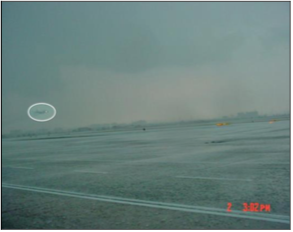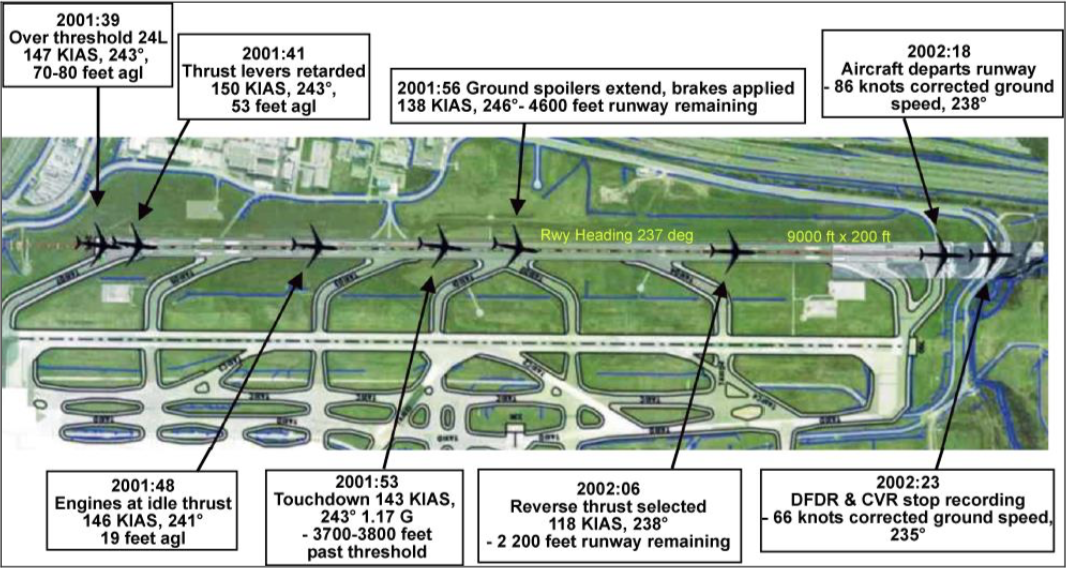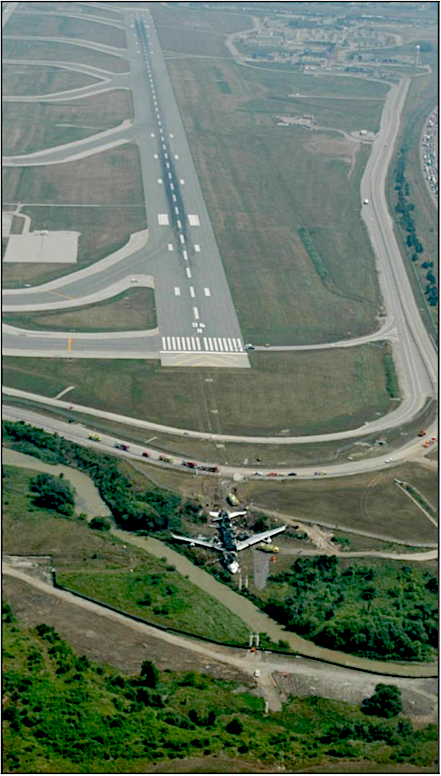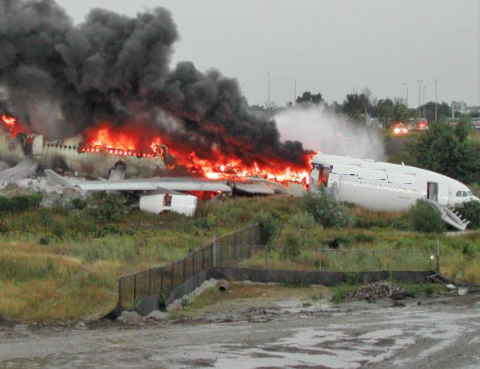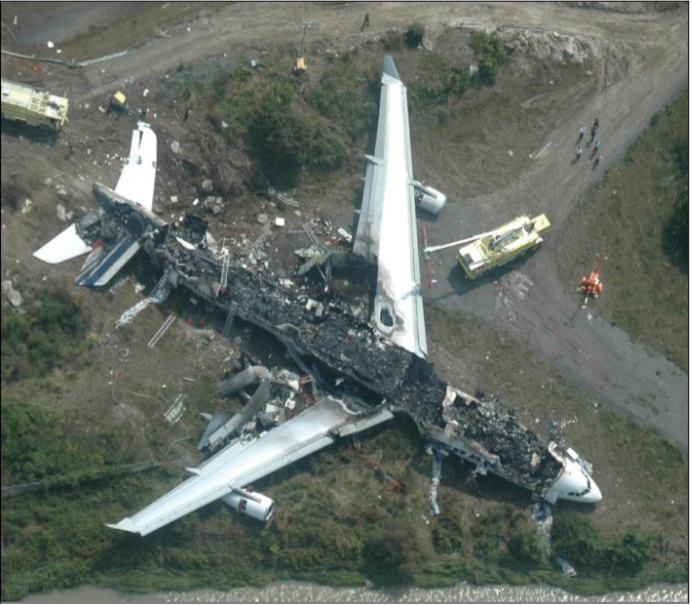Flying Weather - Module E (case ID = f14)
page 3 of 3
Readings and online activities done by each student individually.
The pilot decided to continue the approach to land on runway 24L at Toronto.
The autopilot continued to do a good job flying the aircraft on the desired glideslope toward the runway.
The line of thunderstorms remained over Toronto. One of the thunderstorm cells intensified (dBZ values of about 60,
as shown by the dark red pixels in the photo below). This cell moved over the runway (at the white "X" in the figure).
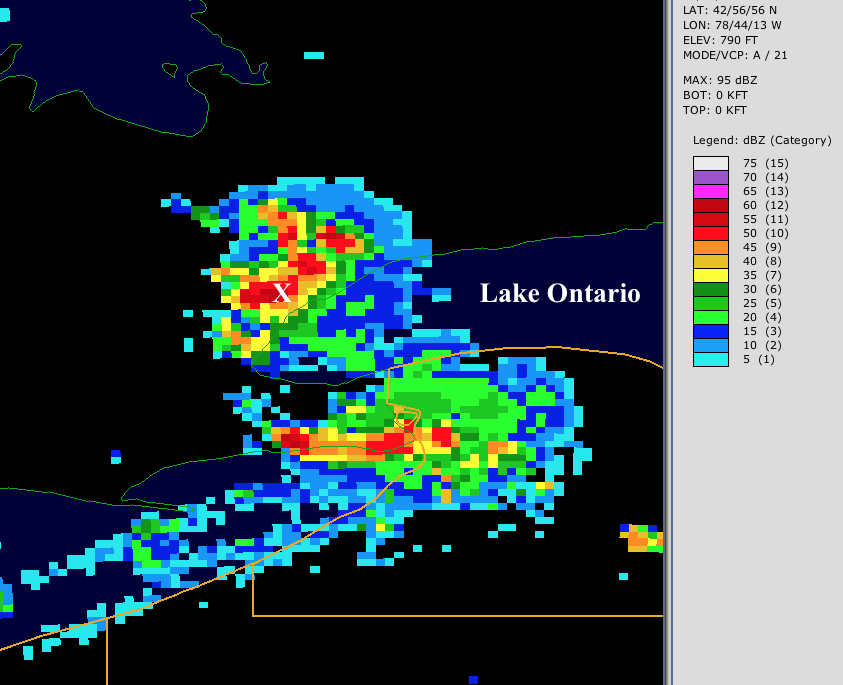
Radar image courtesy of US National Centers for Environmental Information (NCEI): https://www.ncdc.noaa.gov/.
There was a strong 70° to 90° crosswind at 15 to 20 knots at this time. Visiblity decreased to near zero
in heavy rain and low clouds (see the photo below, where the white oval highlights this aircraft just before touchdown).
Lightning continued all around the aircraft, and small hail was reported by some observers on the ground.
There was also a downburst of air from a thunderstorm cell centered roughly 8 km northeast of the runway.
So while the aircraft was still 323 feet above the runway, the pilot disengaged the autopilot and autothrust
so he could fly the aircraft manually.
The outflow of air from the downburst caused a wind shift from a 15 knot crosswind to a 10 knot tailwind
component just before the aircraft touched down. The tailwind had two effects:
- Due to the plane's inertia, the tailwind initially caused the indicated airspeed to decrease.
The pilot reacted by adding power to the engines, to increase the airspeed back to the
desired target speed. However, ...- As the aircraft accelerated due to the combined effects of the tailwind and the extra thrust
from the engines, the groundspeed over the runway was faster than the normal approach speed.
As a result, the aircraft ended up slightly higher than the desired glideslope.
When the aircraft crossed over the runway threshold just before landing, it was 40 feet too high (above the
glideslope). This means that it flew further along the runway centerline than planned before finally touching
down on the runway. When it touched town, it was already 3,800 feet down a runway of total length 9,000 feet.Just before touching down, the plane flew into a regions of strong turbulence and crosswinds from the right.
However, due to the heavy rain and poor visibility, the pilots had difficulty seeing the runway out the front windows,
so they were also looking out the side windows to try to better estimate the position of the plane relative to the runway.
The right crosswind blew the aircraft to left of the centerline, so the pilot tried to compensate with a crab 6° to the
right (namely, the plane was pointed to the right of the runway centerline).
After touching down, the pilot applied the brakes. But the runway was so slippery from all the rain that the
aircraft wasn't stopping fast enough, so the pilot selected full reverse thrust on the engines, roughly 16 seconds
after touching down. They hadn't used reverse thrust sooner because they were too busy/distracted trying to
land and keep the airplane pointed in the right direction in spite of the poor visibility and shifting winds.Due to the combination of the slippery runway (over 3 mm of rain on the runway), the 10 knot tailwind,
and the late application of reverse thrust, the aircraft was going too fast to stop on the runway.
The aircraft slid off of the far end of the runway, down an embankment toward a creek.
While it was sliding down the embankment, a fire started due to the ruptured fuel tanks.
The fire burned the whole top half of the aircraft. But luckily all passengers and crew were able to evacuate
the aircraft, but 2 crew and 10 passengers were seriously injured during the crash and the evaculation.
The aircraft was a total loss.
All photos (except the first one) courtesy of the Transportation Safety Board of Canada, further annotated by Stull.
Sadly, there have been other times when commercial airlines have "overrun" the end of a wet runway
during thunderstorms. (No need to look at each of these unless you want to. Instead, be aware that
landing during thunderstorms has been a problem for many decades.)
1993 - China Airlines flight 605 at Hong Kong. https://en.wikipedia.org/wiki/China_Airlines_Flight_605
1999 - American Airlines flight 1420 at Little Rock, Arkansas, USA. https://en.wikipedia.org/wiki/American_Airlines_Flight_1420
1999 - Quantas flight 1 at Bangkok, Thailand. https://en.wikipedia.org/wiki/Qantas_Flight_1
2000 - Hawaiian Airlines in Tahiti (no links available)
2004 - Lyon Air flight 538 at Surakarta, Indonesia. https://en.wikipedia.org/wiki/Lion_Air_Flight_538
2005 - Air France flight 358 at Toronto, Canada. https://en.wikipedia.org/wiki/Air_France_Flight_358
2007 - TAM Airlines flight 3054 at Sao Paulo, Brazil. https://en.wikipedia.org/wiki/TAM_Airlines_Flight_3054
2009 - American Airlines flight 331 at Kingston, Jamaica. https://en.wikipedia.org/wiki/American_Airlines_Flight_331
2017 - Air Canada flight 623 at Toronto, Canada. https://www.theweathernetwork.com/news/articles/air-canada-plane-skids-off-runway-in-toronto/79771 , and
https://www.thestar.com/news/gta/2017/02/25/safety-board-investigating-toronto-airport-incident-involving-air-canada-flight-from-halifax.html
SUMMARY: The Australian Transportation Safety Board invistigated a similar incident, and confirmed that
runway overruns during thunderstorms happen when the aircraft is too high, too fast, and when
the runway is slippery due to heavy rain.
Extra info for experts; not needed for this course.
Hydroplaning is when the aircraft tires are separated from the runway pavement by a thin layer of water - - for which case the tires slide as if there is zero friction. Namely, you cannot stop very fast. Also, you cannot control which direction the aircraft is pointing because all the wheels are skidding. Cars can also hydroplane if they are driving too fast on a very wet road.
The speed at which a tire hydroplanes on a wet pavement depends only on the tire pressure. Namely, if the tire pressure P is in units of psi (pounds per square inch), then the minimum speed S (knots) to cause hydroplaning on a wet runway is S = 9 x sqrt( P ), where sqrt is the square root.
When rubber tires hydroplane, the water under the tires is under such high pressure that superheated steam forms, which partially melts the portion of the tire touching the wet runway. This rubber damage is called "rubber reversion". http://www.skybrary.aero/index.php/Aquaplaning
The water on the Toronto runway was fairly deep (probably more than 3 mm). A typical tire pressure in an Airbus 340 is about 235 psi. Using the equation above suggests that hydroplaning could happen at groundspeed greater than about 138 knots. The acutal speed of this aircraft when it touched down was 150 knots, which suggests that hydroplaning could have been a factor. However,the investigation after the accident found that hydroplaning was NOT a factor.
For technical details on hydroplaning, see: G.W.H. van Es, 2001: Hydroplaning of modern aircraft tires. NLR-TP-2001-242. The Netherlands. http://www.nlr-atsi.nl/downloads/hydroplaning-of-modern-aircraft-tires.pdf
Post-crash accident investigation
- The pilots were very experienced, had planned for possible weather delays by adding extra fuel before takeoff, and had briefed each other just before landing about actions to take if crosswinds were too strong, or if the runway was too wet. But problems arose for two reasons:
- The thunderstorm weather was so complex and rapidly changing that the pilots were overloaded with too many things happening at once: heavy rain, poor visiblity, turbulence, wind shifts from a crosswind to a tailwind, lightning, relatively deep water on the runway, low fuel supply, some of the guidance and weather observations systems at the airport were offline due to lightning strikes.
- They, and many other pilots at other times and other airports, had successfully landed in thunderstorm conditions. Also, some of the other aircraft ahead of this case-study aircraft had landed successfully. So the pilots probably underestimated the risk.
- As a result of this overload of problems, the pilots were a bit late in recognizing the fact that they were too fast, too far down the runway, with poor braking action. Their reaction was too late to prevent the aircraft crash - - but their actions, nonetheless, prevented any deaths.
- CAUTION: We are interpreting the accident with hindsight, and should not be smug in our critique of the pilots. If any of us were in a similar situation, who is to say whether we would have done as well as the pilots on this flight. This event is presented in this module as motivation for learning how the weather works.
Tips from meteorologists Thunderstorms have the greatest number of aviation hazards of any weather phenomenon, and these hazards change rapidly. Also, the intense portions of the thunderstorm are in a relatively small region (on the order of 1 - 5 km diameter) associated with the thunderstorm cell, but a single thunderstorm cloud can contain multiple cells in different stages of their life cycle. Also, the whole thunderstorm cloud is often moving over the airport, so conditions experienced at one time by a landing aircraft or by a weather instrument might change completely before the next aircraft lands two minutes later.
Also, some of the thunderstorm hazards are invisible (downbursts, gust fronts, wind shear, turbulence) or are sudden and unexpected (lightning). Some airports have wind-shear alert systems and/or Doppler radar to detect the invisible wind shears, which ATC can use to warn the pilots.
Tips from flight safety experts Never underestimate the risks associated with thunderstorms. Don't fly in, or near, thunderstorms. While this advice is easy to follow during the enroute portion of the flight when it is easier to deviate around thunderstorms, it is more difficult when thunderstorms are over the airport where you want to land. The best approach is to be conservative; namely, assume the risks are greater than you can detect, and deviate to an alternate airport or stay in a holding pattern until the storm has passed.
CAUTION: The pilot in command must make the land or abort decision - - air traffic control (ATC) will not make it for you, and ATC will not necessarily close the airport in bad weather.
The riskiest weather is often relatvely rare/infrequent, so pilots get little experience reacting to these extreme conditions. Luckily, flight simulators for commercial airlines can do a good job simulating these extreme conditions, allowing pilots to gain more experience during their re-training certifications.
But it is too easy, and unfair, to judge the outcome after the fact from our armchairs. During an actual flight in difficult instrument conditions when problems start accumulating, the pilot has a very very heavy workload -- all of it stressful.
Accidents often happen not because of a single problem, but because several problems build on top of each other, until there is nothing the pilot can do to avoid an accident. The trick is to break the chain of compounding mistakes earlier.
If you could start over for this particular case study (knowing the actual outcome
from Step 7), what would you do differently?For example, would you make your decision at a different time during the flight planning and the actual flight?
Would you want more or different data to help you make your decision (if so, which data), etc.
Enter your statements into the UBC Connect system, for the module: Step 10.
These count towards your grade (for grade weights, see the Evaluation link from the course home page).
The grade is based on the relevance of your statements for the scenario of this learning module,
and on the indication that you learned from your mistakes (if any), not on the amount of statements you make.
Please be brief/succinct.
| End of Flying Weather Module f14 |
Image credits. (as stated near the figures)
